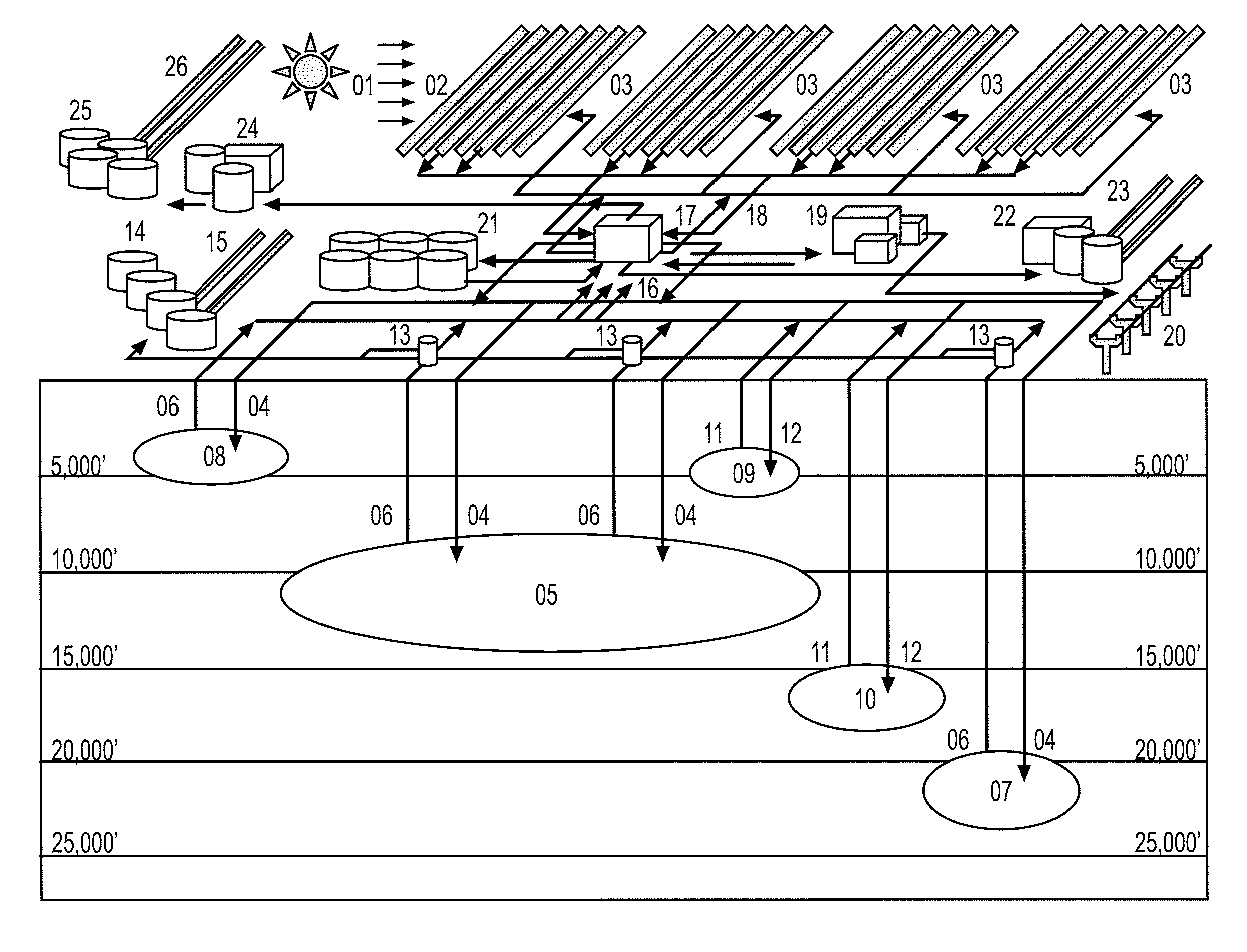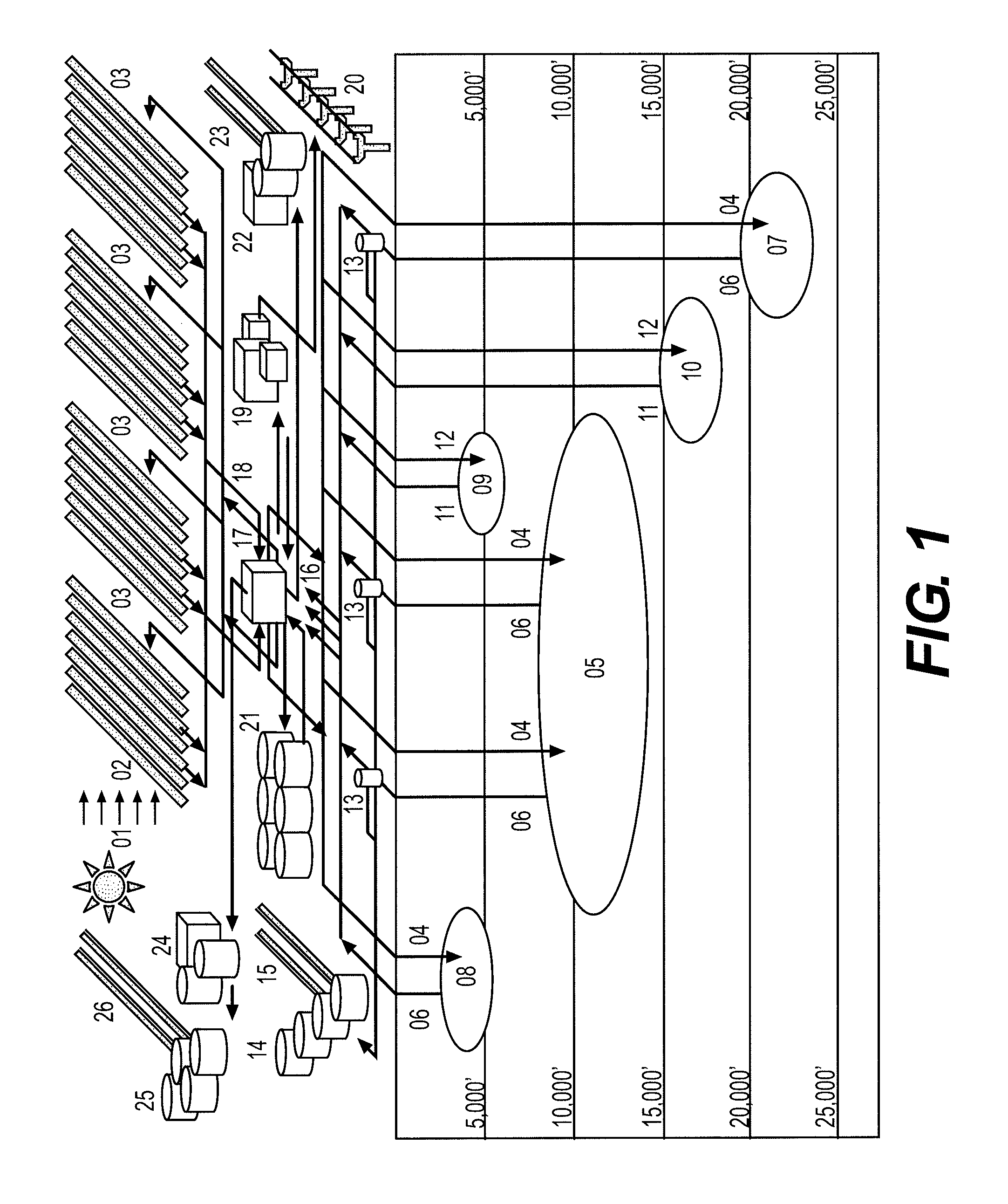Solar augmented geothermal energy
a geothermal energy and solar energy technology, applied in the direction of machines/engines, propulsion parts, borehole/well accessories, etc., can solve the problems of solar energy not being able to deliver base load or peak load electrical power, creating steam required for the process, and affecting the efficiency of solar energy production, etc., to achieve the effect of increasing the value of hydrocarbons and their flow rate, and maximizing oil production
- Summary
- Abstract
- Description
- Claims
- Application Information
AI Technical Summary
Benefits of technology
Problems solved by technology
Method used
Image
Examples
example 1
[0131]In a constructive reduction to practice using data from an analogous solar energy production system, the present invention utilizes subsurface storage of solar energy in porous and permeable strata. The present invention utilizes established permeability and porosity in existing and depleted oil and gas fields, along with their hydrocarbon trapping geometries and in place well bores.
[0132]In the hydrocarbon reservoir strata of the Permian Basin of West Texas, permeability ranges from 2 to over 600 millidarcies. Average porosity ranges from 5 to 21%. Water saturations, which is an indication of available oil field brines, range from 25 to 61%. It should be noted that many of the hydrocarbon reservoirs of the Permian Basin are water driven with flank wells being plugged (or capped, i.e., taken out of production) when the water fraction in the effluent from the wells exceed 95%. Many dry holes have been plugged after 100% water effluent was obtained from these permeable and porou...
example ii
[0138]In a constructive reduction to practice, the present invention is applied to a depleted gas field for immediate development of electrical power, water distillation, and / or other traditional geothermal energy uses.
[0139]On a project by project basis, individual wells may be selected for injection, extraction, or abandonment (plugging of wells deemed unfit for conversion, in order to maintain reservoir pressure and flow integrity). Those wells deemed unfit for conversion may be plugged at lower depths and converted to brine source wells from brine bearing strata well above the targeted thermal reservoir 5.
[0140]The system is then charged with oil field disposal brines and / or natural subsurface brines produced from zones above and / or below the reservoir 5. It should be noted here that many deep depleted gas fields in the United States already have a significant geothermal reserve, bottom hold temperatures often exceeding 150° C. This will assist the efficiency of the present inve...
example iii
[0142]The present invention can be applied to non-producing regions or structural traps which have proven non-productive. These projects will carry a risk associated with limited data and the costs of drilling wells specifically for injection and extraction, rather than converting existing wells. These sites provide the advantage of having the potential to employ the teachings of the present invention, including both establishment of drilling pattern and borehole design tailored to synthetic geothermal injection and extraction.
[0143]It should be noted here that drilling of wells in sedimentary basins is significantly less costly, by a factor of 4, than the drilling of comparable depth wells in a traditional igneous or metamorphic geothermal terrain.
[0144]It is anticipated that initial implementation of the present invention will be undertaken utilizing existing oil and gas fields, depleting or depleted. That development will establish the economic parameters necessary to commerciall...
PUM
 Login to View More
Login to View More Abstract
Description
Claims
Application Information
 Login to View More
Login to View More - R&D
- Intellectual Property
- Life Sciences
- Materials
- Tech Scout
- Unparalleled Data Quality
- Higher Quality Content
- 60% Fewer Hallucinations
Browse by: Latest US Patents, China's latest patents, Technical Efficacy Thesaurus, Application Domain, Technology Topic, Popular Technical Reports.
© 2025 PatSnap. All rights reserved.Legal|Privacy policy|Modern Slavery Act Transparency Statement|Sitemap|About US| Contact US: help@patsnap.com



